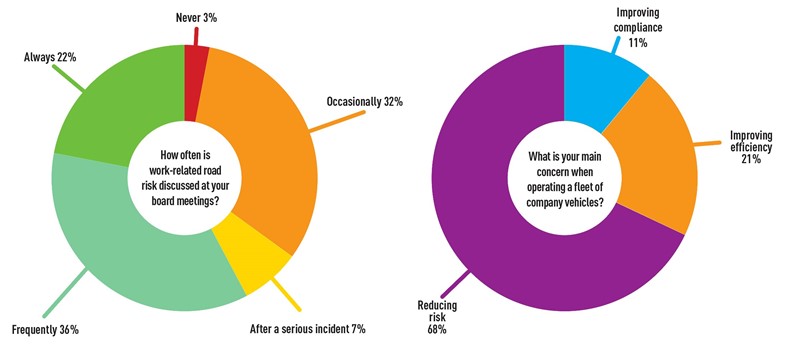Whether you’re running the fleet department or the whole company, a credible commitment to ensuring the safety and wellbeing of your staff is essential. Paying lip service to what needs to be done and then not following through properly will be spotted a mile away by observant staff, who will assume – correctly – that they aren’t really your top priority. It’s just box ticking.
If you believe driver safety is important and needs to be managed well, procedures need to be put in place that highlight failings or opportunities for improvement. It is only when you visibly deal with these issues that you clearly demonstrate to staff that you mean what you say.
Demonstrating leadership in occupational driving is one of the key elements in operating a fleet compliantly because it demands accountability. Accountability ensures that things get done as they are supposed to and that failures in compliance get highlighted and dealt with quickly. Dealing with things quickly ensures drivers see you mean what you say, underpinning your safety culture.
Driving for Better Business (DfBB) recently held a private sector summit on the topic of leadership in work-related road risk where 100 senior business leaders were invited to the McLaren Thought Leadership Centre in Woking, Surrey, to discuss some of the issues.
Martin Temple CBE, chairman of the Health and Safety Executive, talked about this need for effective leadership before asking the assembled delegates how often they discussed work-related road risk at their board meetings, the results were enlightening and slightly concerning.
How often is road risk discussed?
A small number (3%) never discussed work-related road risk at board meetings while 32% – very nearly a third – occasionally discussed it. A further 7% said they discussed it only after a serious incident. That’s a total of 42% of boards that don’t appear to give this issue the time it demands.
However, 36% said they discussed it frequently and less than a quarter (22%) said that it was always discussed at board meetings.
A managing director has ultimate responsibility for the safe operation of the business. Any kind of risk management must be owned by a named director – that includes workplace health and safety more generally, and work-related driving specifically.
The MD might choose to incorporate the fleet safety role within another director’s responsibilities – for instance Fleet, Logistics, Safety, Compliance, etc. – dependent on the structure of the company.
Mismanagement of risk and safety can have a devastating effect on a business when something goes wrong. So, it stands to reason that the director responsible should want to regularly report on performance in this area and a key reason for this is that poor performance can sometimes be laid at the door of other directors who have failed to understand the full impact of their decisions.
Poor performance could be an indicator that other areas of the business are having a negative impact on incidents – for instance, the finance director may have put pressure on the sales director to improve productivity with unrealistic targets, or put pressure on the fleet director to reduce maintenance costs which then had a knock-on impact on vehicle reliability. The HR director may need to tighten up recruitment procedures, improve the driver induction process or communicate policies and safe working procedures more effectively.
Only by discussing incidents and trends at board level can problems like these be identified quickly and dealt with, hopefully before they pose a more serious threat to the business.
This high level of genuine accountability is readily apparent in the thinking of those at the top of many of our Driving for Better Business Champions as indicated here:
“People are at the heart of McLaren Automotive Limited; it is the passion and dedication of our people that has enabled us to achieve the extraordinary success we experience as a business and as a brand. The health, safety and welfare of our people is fundamental to our continued success and this brings us to acknowledge that driving for work is a high risk activity that we need to manage.”
Mike Flewitt, chief executive, McLaren Automotive
“The safety of our colleagues and other road users is of utmost importance. Everything we do as a business centres on our commitment to being 100% safe.”
Simon Smith, managing director, Morgan Sindall Infrastructure
“Our job is to make our highways safer and we cannot do that without a passion for safety. This means that safety and road safety are synonymous – they do not stop at site boundaries, but are embedded deep in the very fabric of our organisation.”
Wayne Johnston, managing director, WJ Group
Martin Temple summarised the findings thus: “More people need to be discussing it at the very top level because we know that is where the message starts. It starts in the boardroom – that’s where the company ethos is, that’s where the values are and that’s where the ambition is.”
The next session at the summit was chaired by Fleet News editor Stephen Briers who said: “During the course of putting together every issue of the magazine we speak to a lot of leading fleets to understand how they work and how they’re addressing the key issues so that we can share their best practice with others. One thing that they all share is great leadership.”
He then asked the audience: “What is your main concern when operating a fleet of company vehicles? Is it improving compliance, improving efficiency or reducing risk?”
What are fleet priorities?

While all delegates attached importance to all three, they were specifically asked which was the one that really drove their commitment to safety. More than two-thirds (68%) cited reducing risk as their primary focus (see pie chart).
In the subsequent discussion, DfBB ambassador Tracey Fuller, UK head of CSR (corporate social responsibility) for Arval and BNP Paribas, advised making the management of work-related road risk part of a CSR strategy, saying: “If you think about your responsibility to reduce the risk to your employees, minimising the risk of them being involved in a collision and protecting communities, then that sits within your CSR strategy.”
Iron Mountain head of fleet Rory Morgan – also an ambassador – warned of complacency setting in after a lot of hard work has gone into minimising that risk: “When you’ve got a good record, there’s that complacency that can pop up and say ‘why do we need to throw any more money at it? We’re good… we’re doing well’. Strong leadership is needed to ensure that hard work is not jeopardised.”
James Haluch, managing director of DfBB champion Amey Highways, said: “I have 5,000 employees and the average age is 54. But to bring new people into our sector, bring in diversity, bring generation Z in, they want to hear what we’re doing for CSR – they want to hear how we’re doing things differently. It isn’t about minimum compliance – they want something extra. As the leader of an organisation, I have seen real tangible bottom line benefits. I’ve seen tangible wellbeing benefits as well. But most of all it comes down to knowing you’re doing your absolute best to make sure your employees, and the people they interact with, go home safe and well.”
This kind of thinking is what increasingly drives the best business leaders.
For them, legal compliance is a given, and the financial benefits are a welcome improvement to the efficiency of the company. But they manage work-related road risk to a high standard as part of their wider health and safety strategy simply because it is the right thing to do.



















Login to comment
Comments
No comments have been made yet.